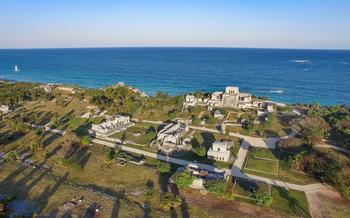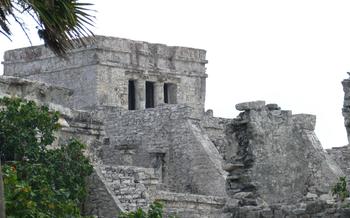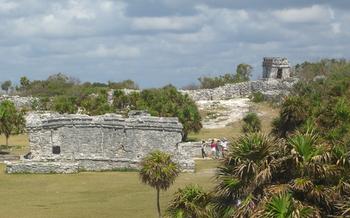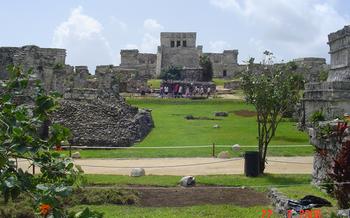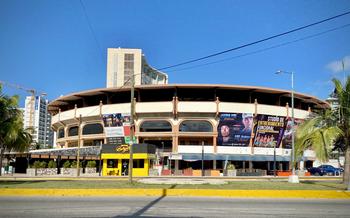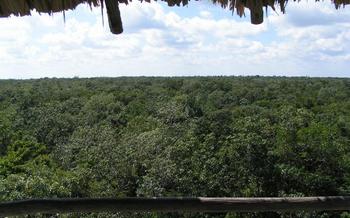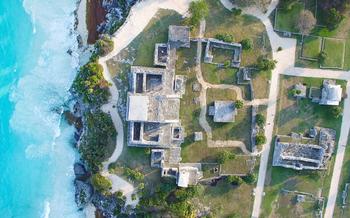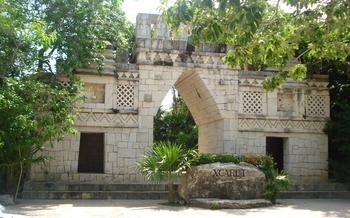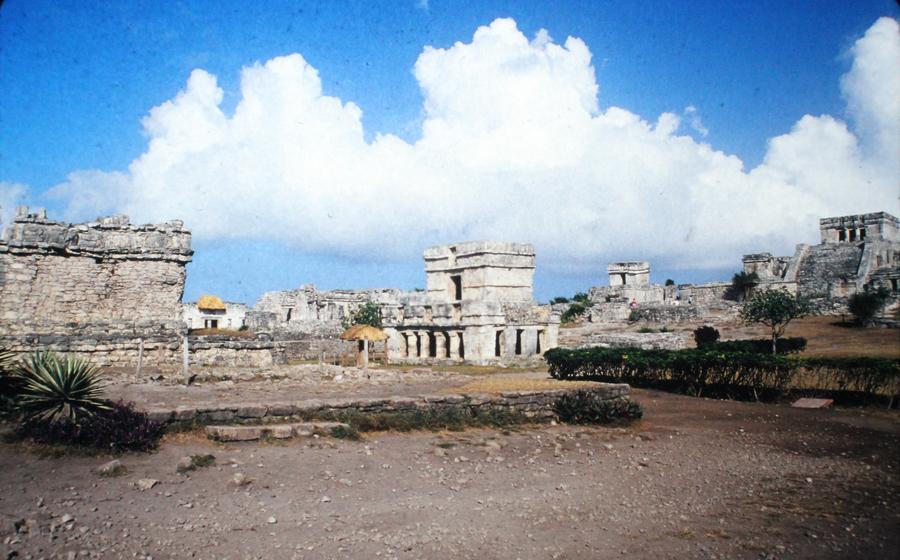
Temple of the Frescoes
- Historical Significance
- Location and Accessibility
- Visiting Hours and Fees
- Guided Tours
- Physical Accessibility
- Photography and Videography
- Dress Code and Attire
- Weather Conditions
- Local Guides and Interpreters
- Souvenirs and Local Crafts
- Safety and Security
- Food and Beverage Options
- Nearby Attractions
- Insider Tip: Unveiling Hidden Gems
Historical Significance
The Temple of the Frescoes, nestled within the ancient Mayan city of Tulum, stands as a testament to the grandeur and complexity of Mayan civilization. Built around the 13th century AD during the Post-Classic period, this remarkable structure served as a sacred ceremonial center and a venue for important rituals and gatherings. Its exquisite frescoes, which adorn the interior walls, offer a glimpse into the vibrant and sophisticated culture of the ancient Maya. The temple's strategic location atop a 12-meter-high cliff overlooking the Caribbean Sea further enhances its significance, as it served as a vital navigational landmark for seafaring traders and pilgrims. Moreover, the Temple of the Frescoes is interconnected with other notable Mayan ruins in the area, such as the Castillo (castle), the Temple of the Initial Series, and the Temple of the Wind, forming a sacred complex that played a crucial role in Mayan religious and political life.
Location and Accessibility
The Temple of the Frescoes is situated within the Tulum Archaeological Zone, a sprawling complex of ancient Mayan ruins located on the Caribbean coast of Mexico. The site is conveniently accessible, situated just a short distance from the town of Tulum. The archaeological zone is well-connected, with paved roads leading directly to the temple, making it easily accessible by car or taxi. Ample parking is available within the zone, although it is advisable to arrive early to secure a spot, particularly during peak tourist seasons. Tulum is well-served by public transportation, with regular buses departing from nearby cities and towns. Visitors can opt to take a guided tour, which often includes transportation to and from the temple.
Visiting Hours and Fees
The Temple of the Frescoes, like many other ancient Mayan ruins in Mexico, is open to the public daily. Visiting hours typically run from 8 am to 5 pm, allowing ample time for exploration and appreciation of the site's historical significance. It's worth noting that these hours may vary during certain times of the year, such as national holidays or special events, so checking the official website or contacting local tourism authorities is recommended for the most up-to-date information.
Regarding entrance fees, there is a standard admission charge for visitors. Adults are usually required to pay a fee, while children and students may be eligible for discounted rates. It's advisable to carry cash as the preferred mode of payment, although some sites may accept credit cards or electronic transactions for added convenience. Remember that these fees contribute to the preservation and maintenance of the archaeological site, ensuring its accessibility for future generations to explore and learn.
Guided Tours
Exploring the Temple of the Frescoes with a knowledgeable guide can greatly enhance your understanding and appreciation of this ancient Mayan site. Guided tours are available in various languages and offer a range of benefits:
-
In-depth Knowledge: Guides provide detailed explanations of the temple's history, symbolism, and significance within Mayan culture, bringing the site to life.
-
Tailored Experience: Tours can be customized to suit your interests and time constraints, ensuring a personalized experience.
-
Local Insights: Guides often share personal anecdotes and insights into the local culture and traditions, offering a deeper connection to the region.
-
Safety and Convenience: Guides navigate the temple grounds, ensuring your safety and helping you avoid crowds or restricted areas.
Prices for guided tours typically range from $20 to $50 per person, depending on the group size and duration. Reputable tour operators such as Mayan Heritage Tours and Tulum Ruins Tours offer a variety of options to choose from. Booking in advance is recommended to secure your spot, especially during peak tourist season.
Physical Accessibility
Navigating the Temple of the Frescoes may pose challenges for visitors with disabilities or reduced mobility. The terrain within the archaeological site is uneven, featuring ancient stone pathways and staircases that can be difficult to maneuver. While ramps or wheelchair-accessible routes are not readily available, visitors can seek assistance from the on-site staff or local guides who may be able to provide support. It's advisable to plan your visit accordingly, considering the physical demands of exploring the temple and prioritizing safety above all else.
Photography and Videography
Photography and videography are generally permitted within the Temple of the Frescoes, allowing visitors to capture the stunning murals and architectural details. However, there are some restrictions to ensure the preservation of the site and respect for Mayan culture.
Flash photography and the use of tripods are prohibited inside the temple to prevent damage to the delicate frescoes. Visitors should also be mindful of other visitors and avoid blocking their views or disrupting their experience.
When it comes to copyright and usage rights, it's essential to remember that the Temple of the Frescoes is a protected historical site. Any commercial use or reproduction of images or videos captured within the temple requires prior authorization from the relevant authorities.
By adhering to these guidelines, visitors can contribute to the preservation of this sacred Mayan site while capturing their own unique memories of the Temple of the Frescoes.
Dress Code and Attire
The Temple of the Frescoes, like many other sacred Mayan sites, requires visitors to adhere to a respectful dress code. When visiting the temple, it's essential to dress modestly and avoid revealing or overly casual clothing. While there's no strict dress code, wearing light and airy fabrics that cover your shoulders and knees is recommended. For footwear, comfortable walking shoes or sandals are ideal, as the temple grounds can be uneven and slippery.
Remember that the Temple of the Frescoes is a place of spiritual significance for the Mayan people. Dressing respectfully shows your understanding and appreciation for their culture and traditions. By following these simple guidelines, you can contribute to preserving the sanctity of this ancient site while ensuring a comfortable and enjoyable visit for yourself and others.
Weather Conditions
Visiting the Temple of the Frescoes is best during the dry season, which runs from November to April. During this time, you can expect warm and sunny days with low humidity and minimal chance of rain. Temperatures typically range from 70 to 85 degrees Fahrenheit (21 to 29 degrees Celsius), making it an ideal time to explore the temple and its surroundings.
While the rainy season from May to October brings lush vegetation and a unique atmosphere to the region, it's essential to be prepared for unpredictable rainfall and higher humidity. The rain can be heavy and frequent, sometimes leading to flooding and muddy trails. If you're visiting during the rainy season, pack waterproof gear, insect repellent, and comfortable shoes with good traction.
No matter when you visit, staying hydrated is crucial, as the heat and humidity can be draining. Bring a reusable water bottle and fill it up at the designated water stations within the archaeological site. Remember that the temple doesn't offer shade, so wearing a hat and sunglasses is recommended to protect yourself from the sun's intensity.
Local Guides and Interpreters
When exploring the Temple of the Frescoes, consider hiring a certified and knowledgeable local guide to enhance your experience. These guides possess a wealth of information about the temple's history, cultural significance, and unique features. They can provide insights into the Mayan civilization, the symbolism of the frescoes, and the role of the temple in ancient Mayan society.
Local guides typically charge a fee for their services, which varies depending on the length and depth of the tour. It's advisable to negotiate the price beforehand and ensure that you are clear about the inclusions and exclusions.
Most guides speak English, but it's worth inquiring if they offer tours in other languages if needed. Hiring a local guide not only supports the local economy but also provides an opportunity for cultural exchange and a deeper understanding of the site's significance.
Souvenirs and Local Crafts
Shopping for souvenirs and local crafts is an excellent way to support the local economy and take home a piece of your Tulum experience. Near the Temple of the Frescoes and in the surrounding area, you can find several markets and shops offering a variety of souvenirs and handmade crafts. From traditional Mayan textiles and pottery to intricate jewelry and wood carvings, there's something for every taste and budget.
When shopping for souvenirs, look for authentic Mayan crafts made by local artisans. These items are often more expensive than mass-produced souvenirs but are of higher quality and help support the local community. You can bargain with vendors, but be respectful and fair in your negotiations.
Remember that the Temple of the Frescoes is a sacred site, and it's important to respect the local culture and traditions. Avoid buying souvenirs that are made from endangered or protected species, and be mindful of any restrictions on the export of certain items.
Safety and Security
Visiting the Temple of the Frescoes is generally safe, but like any tourist destination, it's essential to be aware of your surroundings and take precautions. Keep your valuables secure and avoid displaying expensive jewelry or electronics. While the temple is well-maintained, the terrain can be uneven, so wear comfortable shoes and watch your step. Be mindful of your belongings, as petty theft can occur in crowded areas. If you have any concerns or witness suspicious activity, don't hesitate to approach a park ranger or security guard for assistance. Remember to stay hydrated, especially during the hot and humid summer months, and apply sunscreen to protect yourself from the intense sun. In case of an emergency, dial 911 or the local emergency number for immediate assistance.
Food and Beverage Options
The Temple of the Frescoes, while rich in historical significance, does not offer any food and beverage options within its immediate vicinity. However, visitors can find a range of dining options just a short walk away. From casual cafes to traditional Mayan restaurants, there are plenty of places to satisfy your hunger and thirst.
For a quick bite, grab a refreshing coconut water or a cold beer from one of the many vendors selling fresh produce and drinks outside the temple grounds. If you're looking for a more substantial meal, head to the nearby town of Tulum, where you'll find a variety of restaurants serving everything from traditional Mexican dishes to international cuisine.
One of the must-try dishes in Tulum is "cochinita pibil," a slow-roasted pork dish that is marinated in achiote paste and wrapped in banana leaves. Another local delicacy is "ceviche," a refreshing seafood dish made with fresh fish or shrimp marinated in lime juice and served with chopped onions, cilantro, and avocado.
For those who prefer to pack their own lunch, there are plenty of spots near the temple where you can enjoy a picnic. Just be sure to bring plenty of water, as it can get quite hot and humid in Tulum, especially during the summer months.
Nearby Attractions
The Temple of the Frescoes is just one of many incredible attractions in the Tulum area. In close proximity, history buffs can explore the sprawling ruins of Cobá, where they can climb the ancient Nohoch Mul pyramid for panoramic views of the jungle. For a unique natural encounter, the Gran Cenote, with its crystal-clear waters and underwater caves, offers a refreshing dip and the chance to snorkel among tropical fish.
Those seeking a more laid-back experience can head to the beautiful beaches of Tulum, where they can relax on the soft white sand, swim in the turquoise waters, or soak up the sun's warmth. Just a short drive away, the Sian Ka'an Biosphere Reserve, a UNESCO World Heritage Site, boasts pristine beaches, lush mangroves, and diverse wildlife, providing ample opportunities for hiking, birdwatching, and nature exploration. With so many attractions within easy reach, Tulum offers a perfect blend of history, culture, and natural wonders, ensuring an unforgettable adventure.
Insider Tip: Unveiling Hidden Gems
Secret Spot: Venture beyond the main tourist areas to discover a hidden chamber within the temple, adorned with intricate carvings and offering a serene ambiance away from the crowds. Seek out this secluded spot for a moment of tranquility and introspection.
Unique Photo Opportunity: Position yourself strategically to capture a breathtaking shot of the temple's reflection shimmering in the waters of a nearby cenote. This perspective offers a mesmerizing blend of history and nature, creating a visually stunning image.
Sunrise Serenity: Arrive at the temple before dawn to witness the magical spectacle of the rising sun illuminating the ancient ruins. This ethereal glow casts a warm golden hue over the temple, creating an awe-inspiring sight that will leave you spellbound.
Local Guide Insight: Engage with knowledgeable local guides who can share captivating stories and legends about the temple, providing a deeper understanding of its significance and the rich history of the Maya civilization. Their insights will enhance your experience and leave you with a lasting appreciation for this sacred site.
Off-the-Beaten-Path Cenote: Explore a hidden cenote nestled amidst the lush jungle surrounding the temple. Take a refreshing dip in its crystal-clear waters and soak in the tranquility of this secluded oasis, away from the hustle and bustle of the main tourist areas.


